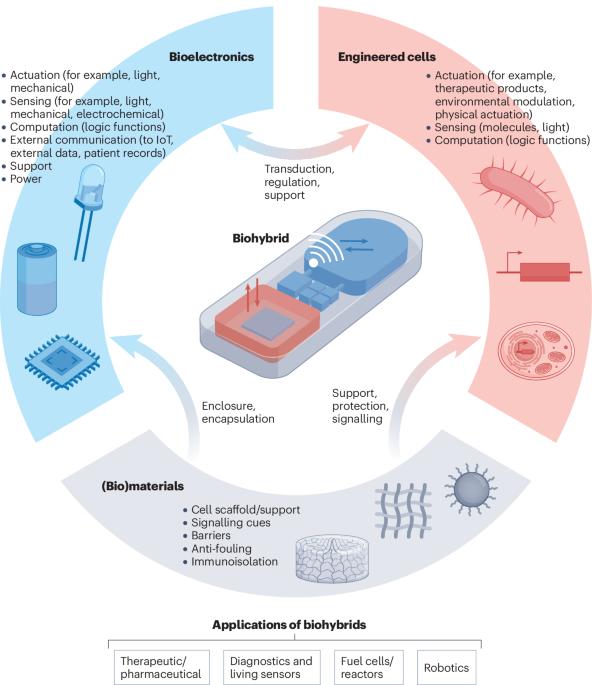Integrating bioelectronics with cell-based synthetic biology
IF 37.6
引用次数: 0
Abstract
Biohybrid devices based on engineered cells interfaced with bioelectronics represent a promising union where the strengths of each field can be synergistically combined, resulting in constructs with properties that are not otherwise achievable. Recent progress in biomaterials and cell-based synthetic biology has resulted in cells that can be remotely triggered via multiple modalities and can access a number of cellular pathways to achieve complex sensing and biomolecule production tasks. Although these living cells can be deployed as next-generation diagnostics and cell-based therapies, they are limited by the fundamental boundaries of biology. Bioelectronics, conversely, has been engineered to leverage the strengths of established computational hardware and software, integrates multiple inputs of biometric and external data, and allows communication over long distances. However, bioelectronics often requires considerable power to perform complex tasks and lacks the specificity and adaptability of cells and tissues. The parallel advances in synthetic biology, biomaterials and bioelectronics therefore present new opportunities in devices for regulated cell therapies, diagnostic tools and next-generation robotics. In this Review, we discuss the enabling mechanisms of communication between engineered cells and bioelectronics platforms, describe the approaches and challenges in assembling and deploying such systems, and highlight recent prototypes. The continued advancement in cell support systems and both internal and external closed-loop control suggest forthcoming breakthrough opportunities for biohybrid bioelectronics. Biohybrid devices based on engineered cells interfaced with bioelectronics combine the strengths of each field, resulting in constructs with properties that are not otherwise achievable. In this Review, we discuss the enabling mechanisms of communication between these domains and describe the approaches and challenges in assembling and deploying such systems.

结合生物电子学与细胞合成生物学
基于工程细胞与生物电子学界面的生物混合装置代表了一个有前途的联盟,其中每个领域的优势可以协同结合,从而产生具有其他方法无法实现的特性的结构。生物材料和基于细胞的合成生物学的最新进展已经导致细胞可以通过多种方式远程触发,并且可以访问许多细胞途径来完成复杂的传感和生物分子生产任务。尽管这些活细胞可以用于下一代诊断和基于细胞的治疗,但它们受到生物学基本界限的限制。相反,生物电子学的设计利用了现有计算硬件和软件的优势,集成了生物特征和外部数据的多种输入,并允许长距离通信。然而,生物电子学通常需要相当大的功率来执行复杂的任务,并且缺乏细胞和组织的特异性和适应性。因此,合成生物学、生物材料和生物电子学的平行发展为调节细胞疗法、诊断工具和下一代机器人设备提供了新的机会。在这篇综述中,我们讨论了工程细胞和生物电子平台之间的通信机制,描述了组装和部署这种系统的方法和挑战,并重点介绍了最近的原型。细胞支持系统和内外闭环控制的持续发展为生物混合生物电子学带来了突破性的机遇。基于工程细胞与生物电子学界面的生物混合装置结合了每个领域的优势,从而产生具有其他方法无法实现的特性的结构。在这篇综述中,我们讨论了这些领域之间通信的使能机制,并描述了组装和部署这些系统的方法和挑战。
本文章由计算机程序翻译,如有差异,请以英文原文为准。
求助全文
约1分钟内获得全文
求助全文

 求助内容:
求助内容: 应助结果提醒方式:
应助结果提醒方式:


